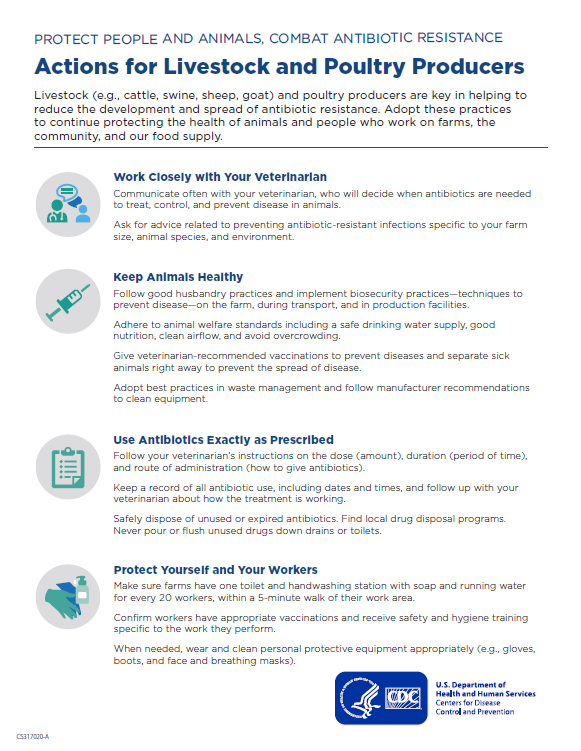Livestock and Poultry Producers: Protect People and Animals
Antibiotic resistance happens when germs develop the ability to defeat the drugs designed to kill them.
Animals, like people, carry germs in their gut, including antibiotic-resistant germs. Resistant germs have been identified in poultry and livestock (e.g., cattle, swine, sheep, and goat) and the food they produce around the world. Antibiotics are valuable tools for treating infections in people and animals, but any time antibiotics are used bacteria can develop antibiotic resistance.
Livestock and poultry producers are key in helping to reduce the development and spread of antibiotic resistance. Adopting these practices to continue protecting the health of animals and people who work on farms, the community, and our food supply.
The Veterinary Feed Directive (VFD) are federal rules that limit the use of antibiotics that are important in treating human diseases in food-producing animals. Veterinarians are responsible for overseeing the use of antibiotics. See FDA’s websiteexternal icon for more information.
Work Closely with Your Veterinarian
- Communicate often with your veterinarian, who will decide when antibiotics are needed to treat, control, and/or prevent disease in animals.
- Ask for advice related to preventing antibiotic-resistant infections specific to your farm size, animal species, and environment.
Keep Animals Healthy
- Follow good husbandry practices and implement biosecurity practices [PDF – 68 pages]external icon—techniques to prevent the introduction and spread of diseases, including cleaning procedures—on the farm, during transport, and in production facilities.
- Adhere to animal welfareexternal icon standards including a safe drinking water supply, good nutrition, clean airflow, and avoid overcrowding.
- Give veterinarian-recommended vaccinations to prevent diseases and separate sick animals right away to prevent the spread of disease.
- Adopt best practices in waste managementexternal icon and follow manufacturer recommendations to clean equipment.
Use Antibiotics Exactly as Prescribed
- Follow your veterinarian’s instructions on the dose (amount), duration (period of time), and route of administration (how to give antibiotics to selected animals).
- Keep a record of all antibiotic use, including dates and times, and follow up with your veterinarian about how the treatment is working.
- Safely disposeexternal icon of unused or expired antibiotics. Find local drug disposal programs. Never pour or flush unused drugs down drains or toilets.
Protect Yourself and Your Workers
- Make sure farms have one toilet and handwashing station with soapexternal icon and running water for every 20 workers, within a 5-minute walk of their work area.
- Confirm workers have appropriate vaccinations and receive safety and hygiene training specific to the work they perform.
- When needed, wear and clean personal protective equipmentexternal icon appropriately (e.g., gloves, boots, and face and breathing masks).
